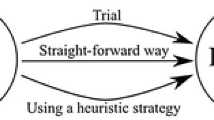Abstract
Problem-solving is one of the main goals in science teaching and is something many students find difficult. This research reports on the development, implementation and evaluation of a problem-solving heuristic. This heuristic intends to help students to understand the steps involved in problem solving (metacognitive tool), and to provide them with an organized approach to tackling problems in a systematic way. This approach guides students by means of logical reasoning to make a qualitative representation of the solution of a problem before undertaking calculations, using a ‘backwards strategy,’ which thus comprises a cognitive tool. The findings of the study suggest that students found the heuristic useful in setting up and solving quantitative chemical problems, and helped them to understand the phases of the problem solving process. Possible applications of the heuristic in the classroom include its use in formative assessment, to identify and to overcome student alternative conceptions, problem-solving in a cooperative environment, and to reduce the gender gap in science.
Article PDF
Similar content being viewed by others
Avoid common mistakes on your manuscript.
References
Ashmore, A.D., Frazer, M.J. & Cassey, R.J. (1979). Problem-solving and problem-solving networks in chemistry. Journal of Chemical Education, 56, 377–379.
Ausubel, D.P. (1968). Educational Psychology: A cognitive view. New York: Holt, Rinehart and Winston.
Ausubel, D.P. & Robinson, P.G. (1971). School learning. New York: Holt, Rinehart and Winston.
Bodner, G.M. (1987). The role of algorithms in teaching problem solving. Journal of Chemical Education, 64, 513–514.
Dalgety, J. & Coll, R.K. (2003). Development of chemistry attitudes and experiences questionnaire (CAEQ). Journal of Research in Science Teaching, 10, 649–668.
Fensham, P., Gunstone, R. & White, R. (1994). The content of science: A constructivist approach to its teaching and learning. London: Falmer Press.
Finegold, M. & Mass, R. (1985). Differences in the process of solving physics problems between good physics problem solvers and poor physics problem solvers. Research in Science and Technological Education, 3, 59–67.
Gabel, D.L. & Bunce, D.M. (1994). Research on problem solving: Chemistry. In Gabel (Ed.), Handbook of research on science teaching and learning: A project of the national science teachers association (pp. 301–326). New York: Macmillan.
Gagne, R.M. (1985). The conditions of learning, 4th edn. New York: Holt, Rinehart and Winston.
Guba, E.G. & Lincoln, Y.S. (1989). Fourth generation evaluation. Newbury Park, CA: Sage.
Guba, E.G. & Lincoln, Y.S. (1994). Competing paradigms in qualitative research. In Denzin & Lincoln (Eds.), Handbook of qualitative research (pp. 105–117). Thousand Oaks, CA: Sage.
Hand, B. & Prain, V. (1995). Teaching and learning in science: The constructivist classroom. Sydney: Harcout Brace.
Hayes, J.R. (1981). The complete problem solver. Philadelphia: Franklin Institute Press.
Heyworth, R.M. (1999). Procedural and conceptual knowledge of expert and novice students for the solving of a basic problem in chemistry. International Journal of Science Education, 21, 195–211.
Kahle, J.B. & Meece, J. (1994). Research on gender issues in the classroom. In Gabel (Ed.), Handbook of research on science teaching and learning: A project of the national science teachers association (pp. 542–557). New York: Macmillan.
Kempa, R.F. & Nicholls, C.E. (1983). Problem-solving ability and cognitive structure: An exploratory investigation. European Joumal of Science Education, 5, 171–184.
Kramers-Pals, H., Lambrechts, J. & Wolff, P.J. (1983). The transformation of quantitative problems to standard problems in general chemistry. European Journal of Science Education, 5, 275–287.
Kramers-Pals, H. & Pilot, A. (1988). Solving quantitative problems: Guidelines for teaching derived from research. International Journal of Science Education, 10, 511–521.
Larkin, J.H. (1983). The role of problem representation in physics. In Gentner & Stevens (Eds.), Mental models (pp. 75–98). Hillsdale, NJ: Lawrence Erlbaum.
Larkin, J. & Reif, F. (1979). Understanding and teaching problem solving in physics. European Journal of Science Education, 7, 191–203.
Lee, L. & Fensham, P.J. (1996). A general strategy for solving high school electrochemistry problems. Journal of Science Education, 18, 543–555.
Maloney, D.P. (1994). Research on problem solving: Physics. In Gabel (Ed.), Handbook of research on science teaching and learning: A project of the national science teachers association (pp. 327–354). New York: Macmillan.
McCalla, J. (2003). Problem solving with pathways. Journal of Chemical Education, 80, 92–98.
McMillan, C. & Swadener, M. (1991). Novice use of qualitative versus quantitative problem solving in electrostatics. Journal of Research in Science Teaching, 28, 661–670.
Merriam, S.B. (1988). Case study research in education. San Francisco: Jossey-Bass.
Mettes, C.T.C.W., Pilot, A., Roossink, H. & Kramers-Pals, H. (1980). Teaching and learning problem solving in science, part I: A general strategy. Journal of Chemical Education, 57, 882–885.
Mettes, C.T.C.W., Pilot, A., Roossink, H. & Kramers-Pals, H. (1981). Teaching and learning problem solving in science, part II: Learning problem solving in a thermodynamic course. Journal of Chemical Education, 58, 51–55.
Newell, A. & Simon, H.A. (1972). Human Problem Solving. Englewood Cliffs, NJ: Prentice-Hall.
Polya, G. (1957). How to solve it. New York: Doubleday & Company.
Reif, F. (1983). How can chemists teach problem solving? Journal of Chemical Education, 60, 948–953.
Simon, D.P. & Simon, H.A. (1978). Individual differences in solving physics problems. In Siegler (Ed.), Children’s thinking: What develops? (pp. 325–348). Hillsdale, NJ: Lawrence Erlbaum.
Vulliamy, G. (1990). The potential of qualitative educational research strategies in developing countries. In Vulliamy, Lewin & Stephens (Eds.), Doing educational research in developing countries (pp. 7–27). London, UK: The Falmer Press.
Zohar, A. & Sela, D. (2003). Physics, his physics: Gender issues in Israeli advanced placement physics classes. International Journal of Science Education, 25, 245–268.
Author information
Authors and Affiliations
Corresponding author
Rights and permissions
This article is published under an open access license. Please check the 'Copyright Information' section either on this page or in the PDF for details of this license and what re-use is permitted. If your intended use exceeds what is permitted by the license or if you are unable to locate the licence and re-use information, please contact the Rights and Permissions team.
About this article
Cite this article
Lorenzo, M. The Development, Implementation, and Evaluation of a Problem Solving Heuristic. Int J Sci Math Educ 3, 33–58 (2005). https://doi.org/10.1007/s10763-004-8359-7
Issue Date:
DOI: https://doi.org/10.1007/s10763-004-8359-7




